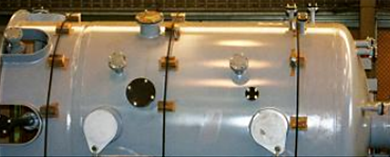
- (03) 5909 8218
- enquiry@fusionweld.com.au
The Importance of Reliability, Quality, and Stability in Gas Storage Vessels
July 10, 2015

Geometry calculations and metallurgical science are the tools of choice when engineering high-quality gas storage vessels. Taking on the roles of equations and steel backbones, they account for in-service operating temperatures and internal pressures as generated by stored gas. Key variables in the equations are derived from a number of constants and variables. The constants are the laws of physics and fluid dynamics. The variables, not surprisingly, are the control elements that the design engineer can shape and configure with some degree of mathematical certitude. The exercise involves balancing geometry with classes of steel and welding techniques, thus forming seams and weld joints that accommodate the safe design limits of the vessel and result in a stable vessel architecture.
A sphere is the ideal shape of gas storage vessels, a profile that the above calculations will always arrive at due to the uniform internal distribution characteristics of a spherical vessel. The spherical vessel can be pressurized to dangerous levels, but there's no weak joint or seam to exploit because the stored gas is pressing equally on every point of the container. Unfortunately, design science chooses to speak at this point, and the news is not good. Spherical gas storage vessels are prohibitively expensive to fabricate and manufacture in bulk, although there are some fine examples out there if you have the time to hunt them down. Each one delivers superior uniformity when it comes to physical and fluid stress resistance.
Returning to our cost-effective cylindrical solutions, these options typically come with two end caps (headers). They're exactingly designed to maximize three attributes, quality in sourced construction material, reliability of engineering mathematics throughout the geometry of the construct, and stability in the final product. This stability factor is a direct consequence of a computer space to fabrication floor approach that understands the nature of vessel construction engineering, the need for a wide safety factor that, nonetheless, does not impact design efficiency. The familiar outline, one that exhibits hemispherical or tori spherical headers, is so familiar in production industry science, that it submits quickly to standard analytical procedures.
The final variable in our calculations comes from these analytical practices, from applying fault simulation models and other simulation scenarios to the vessel. A systematic approach resolves unseen issues and reinforces our stability factor. Rated pressure tests are conducted, vessel material characteristics evaluated, and internal pressure criteria features analysed. The header design and rolled cylindrical body is thus appraised physically, mathematically, and electronically for flaws. The flawless product is then considered an exemplary candidate for ASME Boiler and Pressure Vessel Code Section VIII approval. Going beyond mere engineering prowess, this candidacy classes the vessel as safe for the environment and a compliant product for public safety.
Contact Details
Fusion - Weld Engineering Pty Ltd
ABN 98 068 987619
1865 Frankston Flinders Road,
Hastings, VIC 3915
Ph: (03) 5909 8218
Optimized by NetwizardSEO.com.au
Recent Posts
- Compressed Hydrogen Storage Vessels: Material Selection, Design & Australian Standards
- Welding QA/QC in Oil & Gas Pressure Vessel Fabrication – Ensuring Code Compliance
- AS1210 vs ASME VIII Pressure Vessel Code: Key Differences for Australian Projects
- Mitigating Hydrogen-Induced Cracking in Pressure Vessels: Engineering and Material Strategies
- Storage Tank Solutions Australia: Field-Erected, Prefabricated & Self-Bunded Explained
- Reducing Environmental Risks: Self-Bunded Tanks in Australian Oil & Gas Operations
- Precision in Production: How Pressure Vessels Are Manufactured for Industrial Safety
- Shell & Tube Heat Exchangers: Improve Thermal Control & Energy Recovery in Petrochemical & Pharmaceutical Plants
- In-Service Inspection for Compressed Air Receivers for Power Plant Shutdown Prevention
- Power Plant Pipe Spooling Fabrication – Get Rapid, Code-Compliant Spools Ready for Installation
- Field Erected Tanks: Safe, Reliable On-Site Fuel Storage Solutions in Australia
- Custom Pressure Vessel Fabrication for Flammable Gases
Posts 2025
- Compressed Hydrogen Storage Vessels: Material Selection, Design & Australian Standards
- Welding QA/QC in Oil & Gas Pressure Vessel Fabrication – Ensuring Code Compliance
- View all articles…
Posts 2024
- Large Process Vessels: Optimising the Design for Maximum Efficiency [2025]
- Pressure Equipment Management System Installation: Detect Equipment Faults Early
- View all articles…
Posts 2023
- Pressure Piping System Inspection: A Gift of Safety for the Holidays
- Deaerator Inspections by Fusion-Weld Engineering and How They Reduce System Downtime
- View all articles…
Posts 2022
- How Fusion Weld Keeps Up With AS-NZS ISO 9001:2008 Standard
- Boiler Equipment Safety Inspection During the Summer Season
- View all articles…
Posts 2021
- Avoid These Factors and Practices that Contribute to Sealing Damage in Pressure Vessels
- Do's And Don'ts Of Industrial Boiler Inspection And Maintenance From Fusion-Weld
- View all articles…
Posts 2020
- What are the Risks and Hazards Involved in Pressure Vessel Equipment?
- How to Know if Your Pressure Equipment Needs Repair or Replacement?
- View all articles…
Posts 2019
- Factors that Contribute to Pressure Vessel Failure
- Pressure Vessel Regulations in Australia: What are the Mandatory Requirements?
- View all articles…
Posts 2018
- Pros and Cons of Spherical vs. Cylindrical Pressure Vessels
- What are the Different Hazard Levels in Pressure Vessels?
- View all articles…
Posts 2017
- Transportable Pressure Vessels: The Importance of Inspection and Safety Checks
- Fracture Mechanics and Stress Analysis of Cracks in Pressure Vessels
- View all articles…
Posts 2016
Posts 2015
- What Are Deaerators & Feedwater Vessels?
- Precautions and Safety for Compressed Air Receiver Vessels
- View all articles…
Posts 2014
- Demonstrating In-process Inspection Procedures
- Static Grounding Practices and Standards
- View all articles…